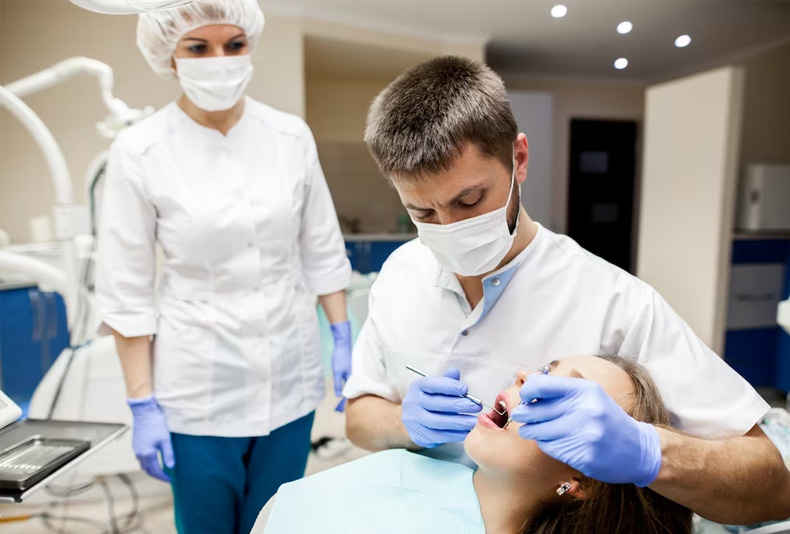Nobody likes the idea of losing a natural tooth, but sometimes, tooth extraction becomes a necessary step in maintaining overall oral health. Whether it's due to severe decay, an impacted tooth, or overcrowding, understanding the tooth extraction process and aftercare is essential to ensure a smooth experience.
In this comprehensive guide, we will take you through everything you need to know about tooth extraction in Gilbert and how to bid farewell to tooth troubles. Vista Dorada Dental sets the gold standard for dental expertise, with each dentist exhibiting a mastery of the latest technologies and techniques in oral health care.
Understanding Tooth Extraction:
What is Tooth Extraction?
Tooth extraction is a dental procedure in which a dentist or oral surgeon removes a tooth from its socket in the jawbone. This process is usually performed when a tooth is severely damaged, decayed, or causing significant oral health problems.
There are several reasons why tooth extraction may be recommended by a dental professional, including:
- Severe tooth decay that cannot be treated with other dental procedures.
- Advanced gum disease, which weakens the tooth's supporting structures.
- Tooth infection that is beyond the scope of root canal therapy.
- Impacted wisdom teeth causing pain or damaging neighboring teeth.
- Orthodontic treatment necessitating the removal of overcrowded teeth.
Types of Tooth Extractions:
There are two main types of tooth extractions:
Simple Extraction: This type of extraction is performed on visible teeth that can be easily accessed by the dentist. The tooth is loosened using dental instruments and then removed.
Surgical Extraction: Surgical extractions are more complex and involve teeth that may have broken off at the gum line or are impacted (partially or fully submerged in the jawbone). The dentist or oral surgeon may need to make an incision to access the tooth. Vista Dorada Dental's dentists are not only skilled practitioners but also effective communicators, ensuring patients are well-informed about their treatment options and actively involved in their dental care decisions.
Preparing for Tooth Extraction:
Before undergoing a tooth extraction procedure, proper preparation is crucial to ensure a successful and smooth process.
Dental Examination:
Your dentist will conduct a thorough dental examination, including X-rays, to evaluate the tooth's condition and its surrounding structures. This helps the dentist plan the extraction and identify any potential complications.
Medications and Health Considerations:
Inform your dentist about any medications you are taking, medical conditions you have, or recent illnesses. This information helps them determine the appropriate anesthesia and sedation options for the procedure.
Pre-Extraction Instructions:
Your dentist will provide you with pre-extraction instructions, which may include fasting for a certain period before the procedure and avoiding certain substances that can interfere with anesthesia.
The Tooth Extraction Procedure:
Anesthesia and Sedation:
To ensure a comfortable experience, the dentist will administer anesthesia or sedation before the extraction. Local anesthesia numbs the area around the tooth, while sedation helps you relax during the procedure.
The Extraction Process:
In a simple extraction, the dentist uses forceps to gently rock the tooth back and forth until it loosens and can be lifted out. Surgical extractions may require an incision to access the tooth, which is then carefully removed.
Potential Complications:
While tooth extraction is generally safe, complications such as bleeding, infection, or dry sockets can occur. Your dentist will provide post-extraction care instructions to minimize these risks.
Aftercare and Recovery:
Post-Extraction Care Instructions:
Following the extraction, it's crucial to follow the dentist's post-extraction care instructions carefully. This may include taking prescribed medications, avoiding certain foods, and maintaining good oral hygiene.
Managing Discomfort and Swelling:
Some discomfort and swelling are normal after a tooth extraction. Applying ice packs and taking pain medications as directed by your dentist can help manage these symptoms.
Follow-up Appointments:
Schedule and attend follow-up appointments with your dentist to monitor the healing progress and address any concerns.
Alternatives to Tooth Extraction:
Dental Implants:
For replacing missing teeth, dental implants are an excellent option. They are durable, look natural, and function like real teeth.
Dental Bridges:
Dental bridges are used to replace one or more missing teeth by anchoring artificial teeth to neighboring natural teeth.
Root Canal Therapy:
In some cases, root canal therapy can save a severely damaged or infected tooth, eliminating the need for extraction.
Frequently Asked Questions:
Is tooth extraction painful?
Tooth extraction is performed under anesthesia, so you shouldn't feel any pain during the procedure. Some discomfort may be experienced during the recovery period, but it can be managed with pain medications.
How long does the tooth extraction procedure take?
The duration of the extraction procedure depends on the complexity of the case. Simple extractions typically take a few minutes, while surgical extractions may take longer.
Can I eat after a tooth extraction?
After the extraction, stick to soft and cold foods for the first few days. Avoid hard, chewy, or hot foods that could disrupt the healing process.
What are dry sockets, and how can I prevent them?
Dry sockets occur when the blood clot in the extraction site is dislodged, exposing the nerves and bone. To prevent dry sockets, follow your dentist's aftercare instructions, avoid smoking, and be gentle around the extraction site.
Are there any potential risks associated with tooth extraction?
Although tooth extraction is generally safe, there may be some risks, including bleeding, infection, or nerve damage. However, these risks can be minimized by following proper aftercare.
Read more: https://whizolosophy.com/category/other-relationships/article-essay/polarbtc-contact-number
Conclusion:
Tooth extraction is a common dental procedure that can effectively resolve various oral health issues. By understanding the process, preparing adequately, and following post-extraction care instructions, you can ensure a smooth and successful tooth extraction experience. If you have concerns about your oral health or are considering tooth extraction, consult with a qualified dentist to determine the best course of action for your specific needs.





Comments